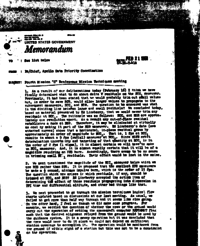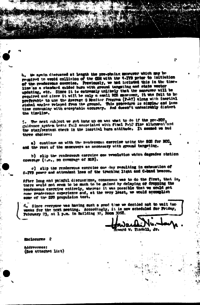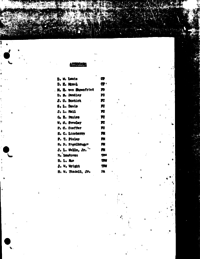Upthread: Third Mission “C” Rendezvous Mission Techniques meeting (Feb 07, 1968)
Downthread: Fifth “C” Mission Rendezvous Mission Techniques meeting (Mar 01, 1968)
See list belowFEB 21 196868-PA-T-41APA/Chief, Apollo Data Priority CoordinationFourth Mission “C” Rendezvous Mission Techniques meeting
1. As a result of our deliberations today (February 16) I think we have finally determined what to do about delta V residuals on the NCC₁ maneuver. Previously, it had been stated that we would probably trim out small values but, in order to save RCS, would allow larger values to propagate to the subsequent maneuvers, NCC₂ and NSR. The question to be answered was what is the dividing line between large and small residuals? We concluded today, based on material presented by Ed Lineberry, that we would never trim any residuals at NCC₁. The rationale was as follows: NCC₁ and NSR are approx- imately one revolution apart. As a result any out-of-plane residual establishes a node at NSR. Therefore, it may be eliminated at virtually no cost by making it part of the NSR maneuver. Ed Lineberry's data (see attached curves) shows that a horizontal, in-plane residual grows by approximately an order of magnitude to NCC₂. That is, 1 fps at NCC₁ results in about a 9 fps (radial) maneuver at NCC₂. Since MSFN orbit determination uncertainty and targeting of that quantity at NCC₁ is in the order or 2 fps (1 sigma), it is almost certain we will have to make an NCC₂ maneuver. And, it is almost equally certain that it will be of a magnitude requiring an SPS burn. Accordingly, there seems to be no sense in trimming small NCC₁ residuals. Their effect would be lost in the noise.
2. We next questioned the magnitude of the NCC₂ maneuver below which we use RCS rather than SPS. It is proposed that the smallest SPS maneuvers be made a ½ second, minimum impulse burn, which is the order of 15 fps. The question which now arises is which residuals, if any, should be trimmed at NCC₂ and NSR? Ed Lineberry accepted the action item of determining the effect of those residuals propagating into dispersion in TPI time and differential altitude, and other bad things like that.
3. We next proceeded to go through the mission techniques logical flow charts updated based on discussions at our last meeting. As usual, we failed to get more than half way through and it seems like slow going. On the other hand, I feel as though we did make some progress. For example, we settled the question of whether the crew or the ground would carry out the operation of setting the spacecraft computer REFSMMAT flag such that the desired alignment relayed from the ground would be used by the guidance system. It is a messy operation but it was concluded that the crew would have to do it since we could not depend on sufficient station coverage to accomplish it. The operation would be monitored from the ground if within sight of a station but this was not to be a constraint on the operation.
4. We again discussed at length the pre-phasing maneuver which may be required to avoid collision of the CSM with the S-IVB prior to initiation of the rendezvous exercise. Previously, we had included this in the time- line as a standard guided burn with ground targeting and state vector updating, etc. Since it is extremely unlikely that the maneuver will be required and since it will be only a small RCS maneuver, it was felt to be preferable to use the Average G Monitor Program (P-47) along with inertial gimbal angles relayed from the ground. This procedure is simpler and less time consuming with acceptable accuracy. And doesn't undesirably distort the timeline.
5. The next subject we got hung up on was what to do if the pre-NCC₁ guidance system tests fail associated with final P-52 fine alignment and the star/sextant check in the inertial burn attitude. It seemed we had three choices:
a) continue on with the rendezvous exercise using the SCS for NCC₁ and the rest of the maneuvers as necessary with ground targeting.
b) slip the rendezvous exercise one revolution which degrades station coverage (i.e., no coverage of NSR).
c) slip the rendezvous exercise one day resulting in exhaustion of S-IVB power and attendant loss of the tracking light and C-band beacon.
After long and painful discussions, consensus was to do the first, that is, there would not seem to be much to be gained by delaying or dropping the rendezvous exercise entirely, whereas it was possible that we could get some rendezvous experience and, at the very least, we would accomplish some of the SPS propulsion test.
6. Since everyone was having such a good time we decided not to wait two weeks for the next meeting. Accordingly, it is now scheduled for Friday, February 23, at 1 p.m. in Building 30, Room 3068.
- Feb 07, 1968 – Third Mission “C” Rendezvous Mission Techniques meeting (9.1σ)




